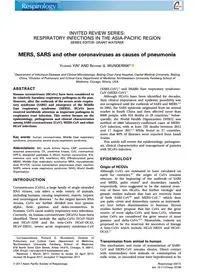
2017 MERS, SARS and other coronaviruses as causes of pneumonia PDF
Preview 2017 MERS, SARS and other coronaviruses as causes of pneumonia
INVITED REVIEW SERIES: RESPIRATORY INFECTIONS IN THE ASIA-PACIFIC REGION SERIES EDITOR: GRANT WATERER MERS, SARS and other coronaviruses as causes of pneumonia YUDONG YIN1 AND RICHARD G. WUNDERINK2 1Department of Infectious Diseases and Clinical Microbiology, Beijing Chao-Yang Hospital, Capital Medical University, Beijing, China; 2Division of Pulmonary and Critical Care, Department of Medicine, Northwestern University Feinberg School of Medicine, Chicago, Illinois, USA ABSTRACT Human coronaviruses (HCoVs) have been considered to be relatively harmless respiratory pathogens in the past. However, after the outbreak of the severe acute respira- tory syndrome (SARS) and emergence of the Middle East respiratory syndrome (MERS), HCoVs have received worldwide attention as important pathogens in respiratory tract infection. This review focuses on the epidemiology, pathogenesis and clinical characteristics among SARS-coronaviruses (CoV), MERS-CoV and other HCoV infections. Key words: human coronaviruses, Middle East respiratory syndrome, pneumonia, severe acute respiratory syndrome. Abbreviations: AKI, acute kidney injury; CAP, community- acquired pneumonia; CK, creatinine kinase; CoV, coronavirus; DPP-4, dipeptidyl peptidase 4; HCoV, human coronavirus; ICU, intensive care unit; IFN, interferon; ISG, IFN-stimulated gene; MERS, Middle East respiratory syndrome; MPA, mycophenolic acid; RT-PCR, reverse transcription polymerase chain reaction; SARS, severe acute respiratory syndrome; WHO, World Health Organization. INTRODUCTION Coronaviruses (CoVs), a large family of single-stranded RNA viruses, can infect a wide variety of animals, including humans, causing respiratory, enteric, hepatic and neurological diseases.1 As the largest known RNA viruses, CoVs are further divided into four genera: alpha-, beta-, gamma- and delta-coronavirus. In humans, CoVs cause mainly respiratory tract infections. Currently, six human coronaviruses (HCoVs) have been identified. These include the alpha-CoVs HCoV-NL63 and HCoV-229E and the beta-CoVs HCoV-OC43, HCoV-HKU1, severe acute respiratory syndrome-CoV (SARS-CoV),2 and Middle East respiratory syndrome- CoV (MERS-CoV).3 Although HCoVs have been identified for decades, their clinical importance and epidemic possibility was not recognized until the outbreak of SARS and MERS.2,3 In 2002, the SARS epidemic originated from an animal market in South China and then affected more than 8000 people, with 916 deaths in 29 countries.4 Subse- quently, the World Health Organization (WHO) was notified of 2066 laboratory-confirmed cases of MERS- CoV infection, with at least 720 deaths between 2012 and 17 August 2017.5 While found in 27 countries, more that 80% of illnesses were reported from Saudi Arabia. This article will review the epidemiology, pathogene- sis, clinical characteristics and management of patients with HCoVs infection. EPIDEMIOLOGY Origin of HCOVs Although CoVs are estimated to have circulated on earth for centuries,6,7 the origin of CoVs remains obscure. At the beginning of the outbreak of SARS and MERS, palm civets8 and dromedary camels,9 respectively, were suggested to be the natural reser- voir of these two HCoVs. But further virologic and genetic studies indicate that bats are reservoir hosts of both SARS-CoV10 and MERS-CoV,11 which then use palm civets and dromedary camels as intermedi- ary host before dissemination to humans. Recent studies further propose that bat CoVs are the gene source of most alpha-CoVs and beta-CoVs, whereas avian CoVs are considered the gene source of most gamma- and delta-CoVs.6,12 Meanwhile, rodents are proposed to be the reservoir for ancestors of lineage A beta-CoVs which include HCoV-HKU1 and HCoV- OC43.13 Transmission from animal to human The mechanism and route of transmission of SARS- CoV and MERS-CoV remains elusive. Direct contact with intermediary host animals or consumption of milk, urine, or uncooked meat were hypothesized to be Correspondence: Richard G. Wunderink, Division of Pulmonary and Critical Care, Department of Medicine, Northwestern University Feinberg School of Medicine, 676 North Saint Clair Street, Arkes 14-015, Chicago, IL 60611, USA. Email:
